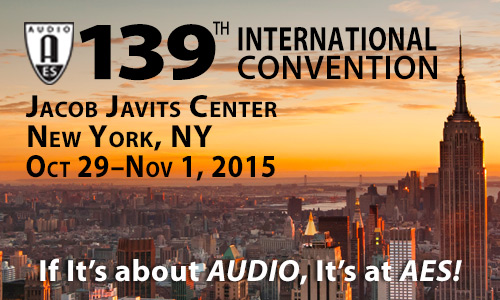
AES New York 2015
Paper Session P23
P23 - Cinema Sound
Sunday, November 1, 2:00 pm — 4:00 pm (Room 1A07)
Chair:
Scott Levine, Skywalker Sound
P23-1 Some Observations on Vinegar Syndrome—Scott Dorsey, Kludge Audio - Williamsburg, VA, USA
In the 1980s it became evident that cellulose triacetate, used as a base for motion picture film and recording tape, was unstable and occasionally suffered from deacetylation with no clear pattern as to which material would be stable and which would not. The author recaps existing research on the nature and basic chemistry of vinegar syndrome, adding some observations of his own on various triggers, and describes a unsuccessful attempt to replasticize damaged film and tape so as to make it playable.
Convention Paper 9480 (Purchase now)
P23-2 Hybrid Channel-Object Approach for Cinema Post-Production Using Particle Systems—Nuno Fonseca, IT/ESTG, Polytechnic Institute of Leiria - Leiria, Portugal
Particle systems are a new sound design approach that is receiving some attention from the cinema community due to the ability to handle thousands of sound sources simultaneously. Unfortunately, current immersive object-based audio formats are not prepared for such scale, forcing sound designers to use traditional channel-based audio approaches. This paper presents a hybrid approach that tries to merge the advantages of both object-based audio and channel-based audio. By using audio-objects with static positions, a high number of virtual “speaker channels” can be created, adding more space resolution than traditional channel-based formats, and allowing the mix of thousands of sounds. The proposed method can be used not only with particle systems software but also on object-based audio downmixing processes or even in high-demanding audio post-production workflows.
Convention Paper 9481 (Purchase now)
P23-3 Measurement of Low Frequencies in Rooms—David Murphy, Krix Loudspeakers - Hackham, South Australia
When aligning and tuning sound systems in commercial cinemas and other rooms there are difficulties with setting an appropriate response for low frequencies and the LFE channel. Long standing practice has been to use pink noise and Real Time Analyzers, but this method is “time blind” and includes the reverberation of the room. A new method is outlined for measuring frequency response at low frequencies. This method uses microphones arranged in a low frequency end-fire array to create useful directivity to discriminate against sound waves from rear wall reflections and reverberation. It also operates in the time domain, processing the acoustic impulse response as it arrives at successive microphones–a shotgun microphone writ large.
Convention Paper 9482 (Purchase now)
P23-4 Subjective Listening Tests for Preferred Room Response in Cinemas-Part 1: System and Test Descriptions—Linda A. Gedemer, University of Salford - Salford, UK; Harman International - Northridge, CA, USA
SMPTE and ISO have specified near identical in-room target response curves for cinemas and dubbing stages. However, to this author's knowledge, to date these standards have never been scientifically tested and validated with modern technology and measurement techniques. For this reason, it is still not known if the current SMPTE and ISO in-room target response curves are optimal or if better solutions exist. This paper describes the Binaural Room Scanning system and listening test methodologies for simulating a cinema sound reproduction system through headphones for the purpose of conducting controlled listening experiments. The method uses a binaural mannequin equipped with a computer-controlled rotating head to accurately capture binaural impulse responses of the sound system and the listening space which are then reproduced via calibrated headphones equipped with a head-tracker. In this way, controlled listening evaluations can be made among different cinema audio systems tuned to different in-room target responses. Two different types of listening tests were developed and are described.
Convention Paper 9483 (Purchase now)

